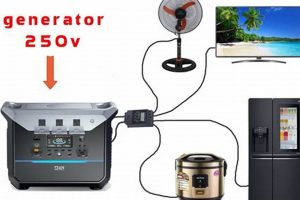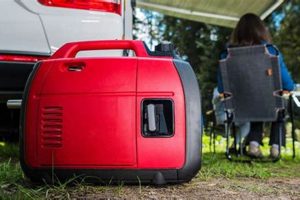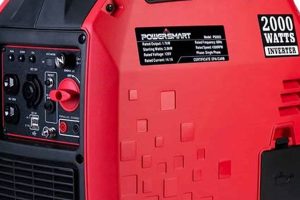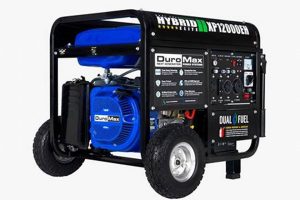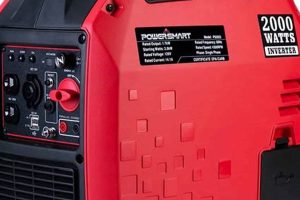Connecting a reserve power source to a residential electrical system provides a critical backup during power outages. This involves safely integrating a compact, gasoline-powered electrical generator with the home’s circuits to maintain essential functions like lighting, refrigeration, and heating. A proper installation often employs a transfer switch to isolate the home’s wiring from the utility grid, preventing backfeeding and protecting utility workers.
Maintaining electrical service during grid failures offers significant advantages, ensuring safety and comfort. Resuming power can prevent food spoilage, maintain comfortable temperatures, and power essential medical equipment. Historically, reliance on backup power has evolved from rudimentary systems to today’s more sophisticated, user-friendly generator technology, reflecting the increasing dependence on electricity in modern life. This dependence underscores the crucial role of reliable backup solutions in mitigating the disruption caused by unexpected power outages.
Several key aspects of safe and effective backup power implementation will be explored. These topics include proper generator sizing, transfer switch installation, safe operating procedures, and essential maintenance considerations. Understanding these elements is vital for anyone considering a backup power solution.
Safe and Effective Portable Generator Connection Tips
Careful planning and execution are essential when integrating a portable generator with a home’s electrical system. These tips emphasize safety and efficiency.
Tip 1: Consult a qualified electrician. Electrical work poses significant risks. Professional consultation ensures adherence to local codes and safe installation practices.
Tip 2: Select the appropriate generator size. Generators are rated in watts. Calculate the wattage required to power essential appliances to avoid overloading the unit.
Tip 3: Install a transfer switch. A transfer switch isolates the home’s wiring from the utility grid, preventing dangerous backfeeding and protecting utility workers. Professional installation is highly recommended.
Tip 4: Position the generator safely. Generators produce carbon monoxide, a deadly gas. Place the generator outdoors in a well-ventilated area, away from doors, windows, and vents.
Tip 5: Allow the generator to cool before refueling. Gasoline is highly flammable. Turn off the generator and allow it to cool completely before adding fuel.
Tip 6: Inspect and maintain the generator regularly. Routine maintenance, including oil changes and spark plug replacements, ensures reliable operation during power outages.
Tip 7: Store fuel safely. Store gasoline in approved containers in a well-ventilated area, away from ignition sources.
Tip 8: Test the system periodically. Conduct periodic tests to ensure the generator and transfer switch function correctly and that you are familiar with the operation process.
Adhering to these guidelines ensures safe and effective portable generator operation, minimizing risks and maximizing the benefits of backup power during outages. A properly installed and maintained system provides peace of mind and essential support when utility power is unavailable.
By understanding and implementing these recommendations, homeowners can ensure the reliable operation of their backup power systems and effectively mitigate the disruptions caused by power outages.
1. Safety First
Connecting a portable generator to a residential electrical system requires careful consideration of safety procedures. Overlooking these procedures can lead to serious hazards, including carbon monoxide poisoning, electrocution, and fire. Prioritizing safety ensures the well-being of individuals and protects property.
- Carbon Monoxide Poisoning Prevention
Generators produce carbon monoxide, an odorless, colorless, and deadly gas. Operating a generator indoors or in poorly ventilated areas can lead to rapid carbon monoxide buildup, resulting in severe health consequences or fatalities. Adequate ventilation is essential. Locating the generator outdoors, far from windows, doors, and vents, minimizes this risk.
- Electrical Shock Prevention
Improper generator connections can create electrocution hazards. Dry hands and proper grounding procedures are crucial when handling electrical components. Use of a transfer switch, professionally installed, isolates the home’s wiring from the utility grid, preventing backfeeding and protecting utility workers from potentially lethal electrical shocks.
- Fire Hazard Mitigation
Gasoline is highly flammable. Spilled fuel near a hot generator presents a significant fire risk. Allowing the generator to cool completely before refueling minimizes this danger. Storing fuel in approved containers, away from ignition sources, further reduces fire hazards. Regular inspection of fuel lines and connections can identify and address potential leaks.
- Proper Grounding and Connection Procedures
Incorrect grounding or connection procedures can damage appliances and create electrical hazards. Following manufacturer instructions and consulting a qualified electrician ensures correct grounding and connection, protecting equipment and individuals. A properly installed transfer switch is critical in managing these connections safely.
Implementing these safety measures transforms potentially hazardous generator operation into a reliable and secure power backup solution. Careful planning and execution mitigate risks and ensure the well-being of individuals and the protection of property during power outages.
2. Proper Sizing
Selecting a correctly sized portable generator is crucial for effectively powering a home during a power outage. An undersized generator will be unable to handle the electrical load, while an oversized generator wastes fuel and increases operating costs. Accurate assessment of power requirements ensures the generator meets the home’s needs without undue strain or unnecessary expense.
- Calculating Wattage Requirements
Determining the necessary generator size begins with calculating the total wattage of appliances intended for use during an outage. This involves identifying essential appliances (refrigerator, furnace, sump pump, etc.) and summing their wattage requirements. Wattage information is typically found on appliance labels or in owner’s manuals. Consider starting wattage (the initial power surge required to start a motor) as well as running wattage (the power needed to maintain operation). Online wattage calculators can simplify this process.
- Starting vs. Running Watts
Appliances with electric motors, like refrigerators and air conditioners, require significantly more power to start than to run continuously. This surge in power demand, known as starting wattage, must be factored into generator sizing. Failure to account for starting wattage can overload the generator, causing it to stall or malfunction. Prioritizing essential appliances during an outage helps manage peak power demand.
- Generator Capacity and Output
Generators are rated by their maximum power output in watts. This rating should exceed the calculated total wattage requirement of the intended appliances, including starting wattage considerations. A safety margin of 20-30% is advisable to accommodate unforeseen loads or future appliance additions. This ensures sufficient power availability during peak demand periods.
- Oversizing and Inefficiency
While sufficient power is critical, an excessively large generator operates inefficiently, consuming more fuel than necessary and increasing operating costs. It also subjects the generator to unnecessary wear and tear. Precisely matching generator capacity to actual power needs optimizes fuel consumption and prolongs generator lifespan. Oversizing provides no practical benefit and leads to increased expenses and potential environmental impact.
Proper generator sizing directly impacts the efficacy of a backup power solution. Accurately assessing power needs and matching them to generator capacity ensures reliable operation, avoids overloads, and optimizes fuel efficiency. This careful planning is essential for a successful and cost-effective backup power strategy during utility outages.
3. Transfer Switch
A transfer switch plays a critical role in safely connecting a portable generator to a residential electrical system. This device acts as a bridge, allowing homeowners to selectively power circuits with either utility power or generator power, but never both simultaneously. This separation is crucial for safety and prevents backfeeding, a dangerous phenomenon where electricity flows from the generator back into the utility grid. Backfeeding poses a significant risk to utility workers who may be unaware of the energized lines, believing them to be de-energized during repairs. For example, a lineman working on what they believe to be a deactivated power line could suffer fatal injuries due to backfed power from a homeowner’s generator. Furthermore, backfeeding can damage the generator and appliances within the home.
Transfer switches come in two main varieties: manual and automatic. Manual transfer switches require the homeowner to physically move a lever or switch to change the power source. Automatic transfer switches, while more expensive, detect a power outage and automatically switch to the generator, providing a seamless transition. Consider a scenario where a homeowner is away during a power outage. With a manual transfer switch, appliances relying on electricity would be without power until their return. An automatic transfer switch would activate the generator immediately, ensuring uninterrupted power to essential systems like refrigerators, freezers, and sump pumps. This automatic functionality is particularly beneficial for individuals who may be unable to operate a manual switch or are frequently away from home.
Integrating a transfer switch is essential for safe and effective generator usage. It safeguards utility workers, protects home appliances, and ensures a reliable power supply during outages. The choice between manual and automatic transfer switches depends on individual needs and budget, but both provide a critical layer of safety and functionality when connecting a portable generator to a home’s electrical circuits. Understanding the role and importance of the transfer switch is fundamental to responsible generator operation.
4. Outdoor Placement
Safe generator operation mandates outdoor placement. Generators produce carbon monoxide, a colorless, odorless, and highly toxic gas. Indoor or enclosed-space operation poses significant health risks, including fatality. Proper outdoor placement protects inhabitants by minimizing carbon monoxide exposure.
- Ventilation
Adequate ventilation is paramount. Open-air placement allows exhaust fumes containing carbon monoxide to dissipate safely. Positioning the generator away from doors, windows, and vents prevents fumes from entering the home. Even partially enclosed spaces, such as garages with open doors, can accumulate dangerous levels of carbon monoxide.
- Distance from Structures
Maintaining a safe distance from buildings minimizes fire hazards and further aids ventilation. Heat generated by the generator can ignite nearby flammable materials. Recommended safe distances vary depending on generator size and fuel type, but a minimum of several feet is typically advisable. Consulting manufacturer guidelines provides specific clearance requirements.
- Level Surface Placement
Operating a generator on a stable, level surface ensures safe and efficient operation. Uneven surfaces can cause fuel spills, increasing fire risks and potentially damaging the generator. A level surface also minimizes vibration, reducing noise and wear on the generator components.
- Weather Protection
While outdoor placement is essential, protecting the generator from the elements prolongs its lifespan and ensures reliable operation. Direct exposure to rain, snow, or excessive sunlight can damage electrical components. A generator cover or a dedicated outdoor enclosure provides necessary protection without hindering ventilation.
Proper outdoor placement is not merely a recommendation but a critical safety requirement for generator operation. Careful consideration of ventilation, distance from structures, surface stability, and weather protection ensures safe and effective power generation during utility outages, protecting both individuals and property.
5. Prevent Backfeeding
Backfeeding, the reverse flow of electricity from a generator into the utility grid, presents a critical safety hazard when connecting a portable generator to a residential electrical system. This reversed current energizes power lines presumed de-energized by utility workers, creating a risk of electrocution during repairs. For instance, a lineman repairing a downed power line, believing it to be safely de-energized, could encounter lethal voltage due to a homeowner’s backfeeding generator. Preventing backfeeding is not merely a precaution but a fundamental safety requirement, safeguarding utility personnel and ensuring a secure power supply during outages.
Several methods effectively prevent backfeeding. The most reliable method involves installing a transfer switch. Transfer switches mechanically isolate the home’s wiring from the utility grid when the generator is in use, eliminating the backfeeding pathway. Interlock kits offer a less expensive alternative, preventing simultaneous connection to both utility and generator power. However, interlock kits require manual intervention, increasing the risk of human error. Directly connecting the generator to individual appliances through approved extension cords avoids backfeeding but limits the number of powered appliances. Each method offers a different approach to backfeeding prevention, but the principle remains consistent: complete separation between generator power and the utility grid.
Understanding the hazards of backfeeding and implementing preventive measures is paramount for responsible generator operation. A transfer switch, while representing an initial investment, offers the most comprehensive and reliable protection against backfeeding. Simpler methods like interlock kits or direct appliance connections require vigilant attention to safety protocols. Failure to prevent backfeeding jeopardizes the safety of utility workers and undermines the intended purpose of backup power reliable and secure electricity during grid outages. Prioritizing backfeeding prevention ensures both safety and peace of mind.
6. Regular Maintenance
Regular maintenance is essential for the safe and reliable operation of a portable generator connected to a residential electrical system. Neglecting routine maintenance can lead to decreased performance, increased fuel consumption, unexpected failures during outages, and potentially hazardous operating conditions. A well-maintained generator ensures consistent power delivery when needed most, mitigating the disruption caused by utility power failures. For example, a homeowner relying on a generator for essential medical equipment during a power outage could face serious consequences if the generator fails due to neglected maintenance.
Several key maintenance tasks contribute to optimal generator performance and longevity. Regular oil changes, as specified in the manufacturer’s instructions, are crucial for lubricating engine components and preventing premature wear. Air filter replacements ensure proper airflow, maximizing combustion efficiency and minimizing fuel consumption. Spark plug inspection and replacement maintain consistent ignition and prevent engine misfires. Fuel system maintenance, including fuel stabilizer usage and occasional draining of the fuel tank, prevents fuel degradation and carburetor clogging. These preventative measures ensure reliable starting and smooth operation during outages. For instance, failing to stabilize fuel during periods of inactivity can lead to gumming and clogging, rendering the generator inoperable when needed. Similarly, neglecting air filter replacement can restrict airflow, leading to reduced power output and increased fuel consumption.
Regular maintenance is not merely a recommendation but a critical aspect of responsible generator ownership. It ensures reliable performance, extends the generator’s lifespan, and mitigates potential hazards. A comprehensive maintenance schedule, adhering to manufacturer guidelines, safeguards the investment in backup power and guarantees its availability during critical power outages. The consequences of neglecting maintenance can range from inconvenience to severe disruptions and safety risks, underscoring the practical significance of routine generator care within the context of a residential power backup solution. A well-maintained generator provides peace of mind and a dependable source of power when utility service is interrupted.
7. Professional Installation
Safe and effective integration of a portable generator into a residential electrical system necessitates professional installation. Incorrect wiring, improper grounding, or inadequate safety measures can lead to significant hazards, including fire, electrocution, and damage to appliances. Professional expertise ensures adherence to electrical codes, minimizing risks and maximizing the efficacy of the backup power solution. Attempting a do-it-yourself installation without sufficient electrical knowledge and experience can jeopardize safety and compromise the reliability of the system.
- Code Compliance
Electrical codes dictate specific wiring methods, grounding procedures, and safety device installations. Licensed electricians possess the knowledge and experience to ensure compliance with these codes, minimizing risks and ensuring a safe installation. Non-compliant installations can lead to inspections failures, fines, and potential hazards. For example, incorrect wiring can overload circuits, increasing fire risk. Professional installations adhere to code requirements, safeguarding both the homeowner and the electrical system.
- Transfer Switch Installation
Transfer switches, critical for preventing backfeeding and isolating the home’s wiring from the utility grid, require precise wiring and configuration. Professional electricians ensure proper transfer switch integration, minimizing the risk of backfeeding and protecting utility workers from electrocution hazards. Incorrect transfer switch installation can negate its protective function, jeopardizing safety. Professional expertise ensures correct functionality and safe operation.
- Grounding and Bonding
Proper grounding and bonding are essential for preventing electrical shocks and protecting sensitive electronic equipment. Professional electricians understand the intricacies of grounding systems and ensure correct implementation, minimizing shock hazards and safeguarding appliances. Inadequate grounding can lead to electrical shocks, equipment damage, and system instability. Professional installation guarantees a safe and functional grounding system.
- Load Calculations and Generator Sizing
Determining the appropriate generator size involves careful load calculations, considering both running and starting wattage requirements of intended appliances. Licensed electricians can accurately assess power needs and recommend a suitably sized generator, preventing overloads and ensuring sufficient power availability during outages. An incorrectly sized generator can lead to system failures, appliance damage, and insufficient power delivery during critical periods. Professional guidance ensures a properly sized generator for optimal performance and reliability.
Professional installation mitigates risks associated with improper generator connection, ensuring safety, code compliance, and reliable operation. The expertise of licensed electricians safeguards homeowners and protects the electrical system, maximizing the effectiveness of the backup power solution and providing peace of mind during utility outages. Choosing professional installation over a DIY approach represents an investment in safety, reliability, and long-term functionality of the backup power system, ensuring a secure and dependable power source when needed most.
Frequently Asked Questions
Addressing common inquiries regarding residential portable generator connections clarifies crucial safety and operational aspects. Understanding these points ensures effective and secure backup power implementation.
Question 1: What is the safest way to connect a portable generator to a home’s electrical system?
The safest connection method involves a professionally installed transfer switch. Transfer switches isolate the home’s wiring from the utility grid, preventing backfeeding and protecting both utility workers and household appliances.
Question 2: Is it safe to operate a portable generator indoors or in an attached garage?
Operating a portable generator indoors or in an attached garage, even with open doors or windows, presents a significant risk of carbon monoxide poisoning. Generators must always be operated outdoors in a well-ventilated area, far from any openings into the home.
Question 3: How is the correct generator size determined for a specific home?
Proper generator sizing requires calculating the total wattage of essential appliances intended for use during an outage. Consider both running wattage and starting wattage (the higher power surge required to start motors). Online wattage calculators and electrician consultations can assist with this process.
Question 4: What are the potential hazards of backfeeding?
Backfeeding, where electricity flows from the generator back into the utility grid, poses a severe electrocution risk to utility workers. It can also damage the generator and household appliances. Transfer switches prevent backfeeding by isolating the home’s wiring from the utility grid during generator operation.
Question 5: How frequently should a portable generator undergo maintenance?
Adhere to the manufacturer’s recommended maintenance schedule for oil changes, air filter replacements, spark plug inspections, and other routine tasks. Regular maintenance ensures reliable operation, prolongs generator lifespan, and minimizes the risk of malfunctions during outages.
Question 6: Can a homeowner connect a portable generator to their home’s electrical system without professional assistance?
While technically feasible, professional installation is strongly recommended. Licensed electricians possess the expertise to ensure code compliance, safe wiring practices, and proper transfer switch integration, minimizing hazards and maximizing the effectiveness of the backup power solution.
Prioritizing safety and understanding operational requirements are crucial for successful portable generator integration. Professional guidance ensures the establishment of a secure and dependable backup power system.
Further information regarding specific local regulations and individualized requirements should be obtained from qualified electrical professionals and relevant authorities.
Connecting a Portable Generator to a Residential Electrical System
Residential power loss presents significant disruption. Connecting a portable generator provides a crucial backup solution, mitigating the impact of outages. Safe and effective implementation requires careful consideration of several key factors. Proper generator sizing ensures adequate power for essential appliances. Transfer switch installation prevents hazardous backfeeding and protects utility workers. Adherence to safety protocols, including outdoor placement and ventilation, minimizes risks associated with carbon monoxide poisoning. Regular maintenance guarantees reliable operation during critical periods. Professional installation ensures code compliance and minimizes potential hazards.
Reliable backup power is an investment in safety, security, and continuity. Thorough planning and professional guidance transform potential hazards into a dependable safeguard against the disruptive effects of power outages. A well-designed and properly maintained generator connection empowers homeowners to navigate power disruptions with confidence, ensuring the ongoing function of essential systems and enhancing overall well-being during unforeseen circumstances.

